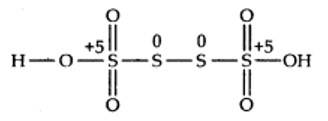Redox Reactions
Get insights from 164 questions on Redox Reactions, answered by students, alumni, and experts. You may also ask and answer any question you like about Redox Reactions
Follow Ask QuestionQuestions
Discussions
Active Users
Followers
New answer posted
6 months agoContributor-Level 10
Writing the O.N. of each atom above its symbol, we have,

here, the O.N. of F decreases from 0 in F2 to -1 in HF and increases from 0 in F2 to +1 in HOF. Therefore, F2 is both reduced as well as oxidised. Thus, it is a redox reaction and more specifically, it is a disproportionation reaction.
New answer posted
6 months agoContributor-Level 10
(a) Here, O is removed from CuO, therefore, it is reduced to Cu, while O is added to H2 to form H2O, therefore, it is oxidised. Further, O.N. of Cu decreases from +2 in CuO to 0 in Cu but that of H increases from 0 in H2 to +1 in H20. Therefore, CuO is reduced to Cu but H2 is oxidised to H2O. Thus, this is a redox reaction.
(b) Here O.N. of Fe decreases from +3 in Fe2O3 to 0 in Fe while that of C increases from +2 in CO to +4 in CO2. Further, oxygen is removed from Fe2O3 and added to CO, therefore, Fe2O3 is reduced while CO is oxidised. Thus, this is a redox reaction.
(c) Here, O.N. of B decreas
New answer posted
6 months agoContributor-Level 10
(a) In Kl3, since the oxidation number of K is +1, therefore, the average oxidation number of iodine = -1/3. But the oxidation number cannot be fractional. Therefore, we must consider its structure, K+ [I —I < I]–. Here, a coordinate bond is formed between I2 molecule and I– ion. The oxidation number of two iodine atoms forming the I2 molecule is zero, while that of iodine forming the coordinate bond is -1. Thus, the oxidation number of the three I atoms, atoms in Kl3 is 0, 0 and -1, respectively.
(b) By conventional method O.N. of S in H2S4O6is calculated as:
2 (+1) +4x + 6) (-2) = 0
Or x = +2.5
But all the four
New answer posted
6 months agoContributor-Level 10
Let x be the oxidation number to the underlined elements in the given species:
(a) NaH2PO4
(+1) + 2 (+1) + x + 4 (-2) = 0
x + 3 – 8 = 0
x = +5
(b) NaHSO4
(+1) + (+1) + x + 4 (-2) = 0
x – 6 = 0
x = +6
(c) H4P2O7
4 (+1) + 2x + 7 (-2) = 0
2x -10 =0
x = +5
(d) K2MnO4
2 (+1) + x + 4 (-2) = 0
x – 6 = 0
x = +6
(e) CaO2
2 + 2x = 0
x = -1
(f) NaBH4
1 + x + 4 (-1) = 0 (Since H is present as hydride ion.)
x = +3
(g) H2S2O7
2 (+1) + 2x + 7 (-2) = 0
x = +6
(h) KAl (SO4)2.12H2O
+1 + 3 + 2x + 8 (-2) + 12 (2 x 1 - 2) = 0
x = +6
Taking an Exam? Selecting a College?
Get authentic answers from experts, students and alumni that you won't find anywhere else
Sign Up on ShikshaOn Shiksha, get access to
- 65k Colleges
- 1.2k Exams
- 679k Reviews
- 1800k Answers




